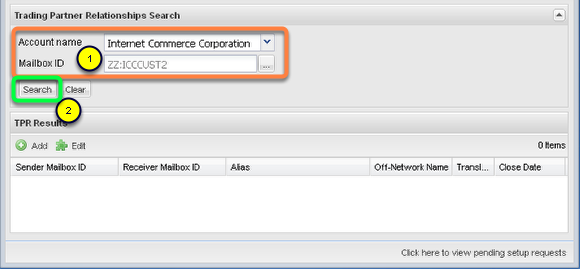Trading Partner Search
- Search for all of the Trading Partner Relationships for one of your Mailboxes
- Determine from the results if it is enabled or disabled, if it requires translation, or if it is defined with an off-network end-point.
Execute the Search.
See the "Trading Partner Relationship Management At Large" page for and overview of the search form and results grid.
- The Trading Partner Relationship Search form uses the standard shared Account Name and Mailbox Selection window controls to select the search criteria.
- After selecting a Mailbox, click Search to submit the form.
- The blue text in the Sender Mailbox ID or Receiver Mailbox ID denotes your Mailbox ID, and will always be the same mailbox selected as the search criteria in item 1 above.
- The green text denotes a Trading Partner Mailbox. You may not select a row where the Trading Partner Mailbox is the Sender, and click "Edit". Your mailbox must always be in the Sender column if you wish to edit the record.
Note: When you submit the search, your window state will be saved and retrieved the next time you login or refresh your browser window. However, when your Trading Partner Relationship Search windows state is restored, the window will reopen, reposition and resize itself, and populate the Search form. However the Search form will not automatically be submitted. Press the Search button if you wish to repopulate the TPR Results grid.
Grid Results - Columns
As mentioned in the introductory section, the records can be sorted by any column, columns can be hidden or un-hidden, and results can further be filtered by column.
1) Description of Columns:
- Sender Mailbox ID: A TPR record is allowed to be configured differently when you send data versus when you receive data. This column denotes which mailbox is the sender.
- Receiver Mailbox ID: A TPR record is allowed to be configured differently when you send data versus when you receive data. This column denotes which mailbox is the receiver.
- Alias: This is a "human readable name/description" string applied to the relationship.
- Off-Network Name: Your Trading Partner may subscribe to VAN services on a competing VAN. This is the name alias applied to our connection to that peer/VAN.
- Translation: This is a flag to denote if the data sent in the direction from the Sender to Receiver requires data translation service.
- Close Date: This will be empty/null if the relationship is enabled, and the date when it was marked disabled/closed if the relationship is not enabled.
2) As many Trading Partner Relationship requests [whether Add or Edit] may require Customer Service involvement to complete, a link to the Support Ticket Center is provided for your convenience.

